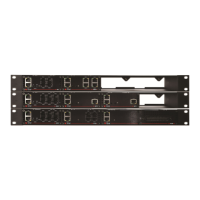QX50/QX200/QX2000; (SW Version 6.0.x) 102
QX50/QX200/QX2000 Manual II: Administrator’s Guide
{ } A character or a string from the specified set of characters and strings.
The following control symbols are used to specify a set:
• Use a comma (,) to separate the elements of a set.
Please Note: No spaces are allowed within braces.
Example:
The pattern is 9{1,3,11,a}.
Numbers matching the pattern are 91, 93 , 911, 9a.
• Use a minus sign (-) to specify a range of characters. Each successive element of the range is obtained by increasing the previous
element (the element code) by one.
Example:
The pattern is 2{11-15,a-d}5.
Numbers matching the pattern are 2115, 2125, 2135, 2145, 2155, 2a5, 2b5, 2c5, 2d5.
• Use an exclamation point to exclude a character or a string from a set.
Example:
The pattern is 2{11-15,a-d,!14,!c}5.
Numbers matching the pattern are 2115, 2125, 2135, 2155, 2a5, 2b5, 2d5.
Please Note: You can use the wildcard ? within the braces, but not *. Thus, {12-104,15?,36?} is a valid pattern, whereas
{15*,36*} is not.
Please Note: The symbol ! cannot be used to exclude a range of symbols. For example 2{15-60,!23-32} or 2{15-60,!23-!32}
are not valid patterns. To valid pattern will be to 2{15-22,33-60}.
[] The same as above with the exception that character ranges can include single-digit/character elements only.
Example:
The pattern is 2[1-5, a-c]5.
Numbers matching the pattern are 215, 225, 235, 245, 255, 2a5, 2b5, 2c5.
\ Precedes a control symbol (*, ?, -, ! and , ) to indicate that it is used as an ordinary character, not a wildcard.
Example:
The pattern is 1\*[1-3]
Numbers matching the pattern are: 1*1, 1*2, 1*3
Please Note: Patterns cannot be prefixed with the * symbol. The system considers the patterns starting with * as feature codes and
does not parse them through the Call Routing table.
@ Used to indicate the full SIP address (example: 20233@sip.epygi.com). This pattern is mainly used to call back users registered on the
SIP server different from the one where the called party is registered.
Please Note: Patterns containing @ symbol will not be parsed among those that do not have @ symbol in the Call Routing Table.
When calling from local extensions (the calling number for local extension is sipnumber@ip_address_of_QX, e.g.
20233@192.168.35.25), only the sipnumber part of the pattern will be parsed among other entries with @ symbol in the Call Routing
Table.
Best Matching Algorithm
All calls through and within a QX IP PBX are made according to call routing patterns that specify a destination based on a dialed number. When a user dials
a number to make a call, the QX IP PBX matches the dialed number against the existing patterns that are specified in the Call Routing table. If the dialed
number matches only to a single pattern, this pattern will be used to set up a call. If several patterns have been found to match the number, the QX IP PBX
uses the Best Matching Algorithm to prioritize the matching patterns. Once the patterns are prioritized, the pattern with the highest priority will be used
as a preferred route for call setup. The successive patterns will be used only if the destination specified by a higher priority pattern is unreachable.
To prioritize the matching patterns, the following criteria are sequentially applied to matching patterns. The criteria are ordered by their priorities: Each
consecutive criterion is calculated only for the patterns that take the same value for the preceding criteria: that is Criterion 3 is calculated only for patterns
that take the same value for Criterion 1 and Criterion 2.
Criterion 1
The presence of asterisks (“*”) in a pattern
The patterns without “*” have a higher priority.





